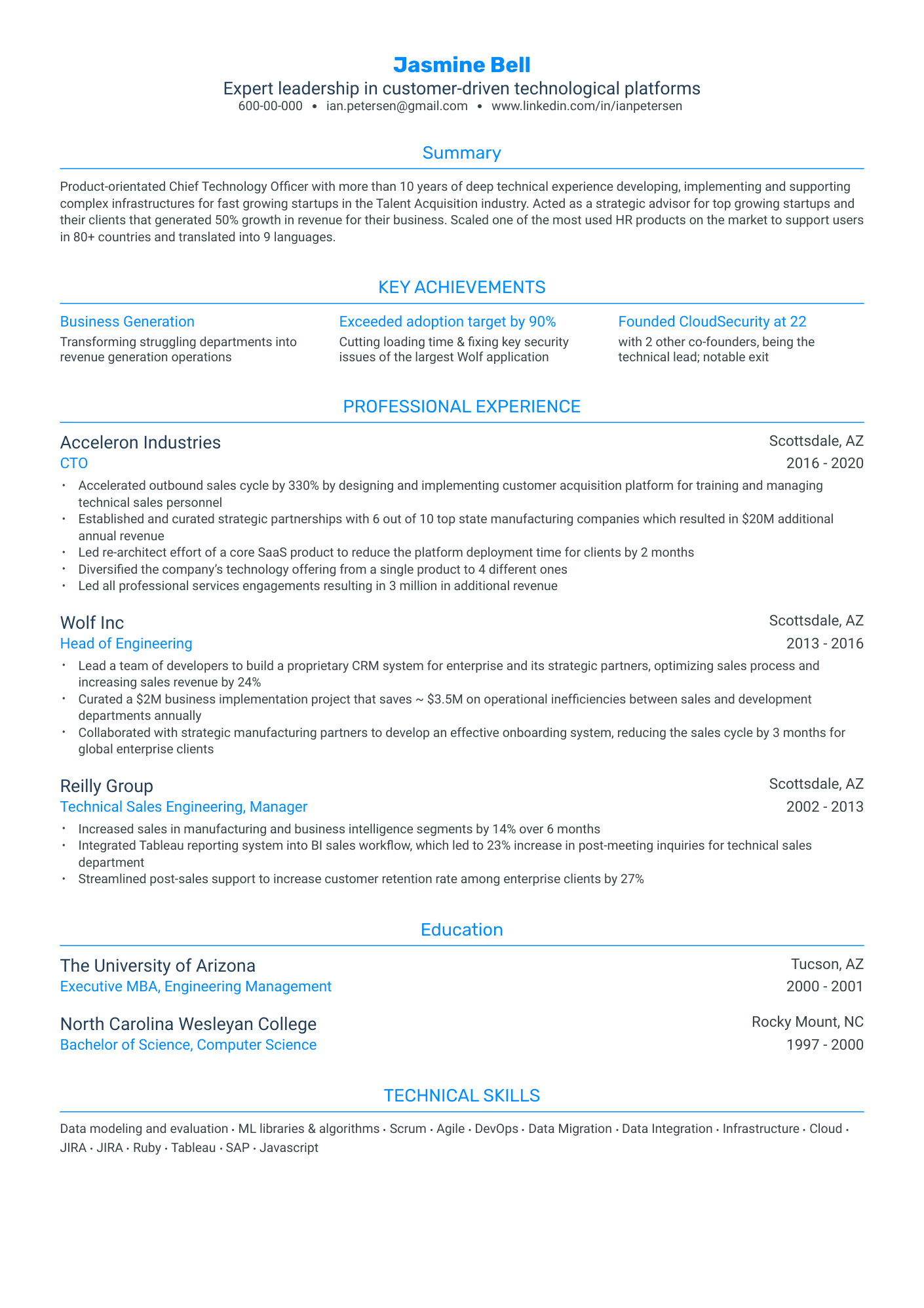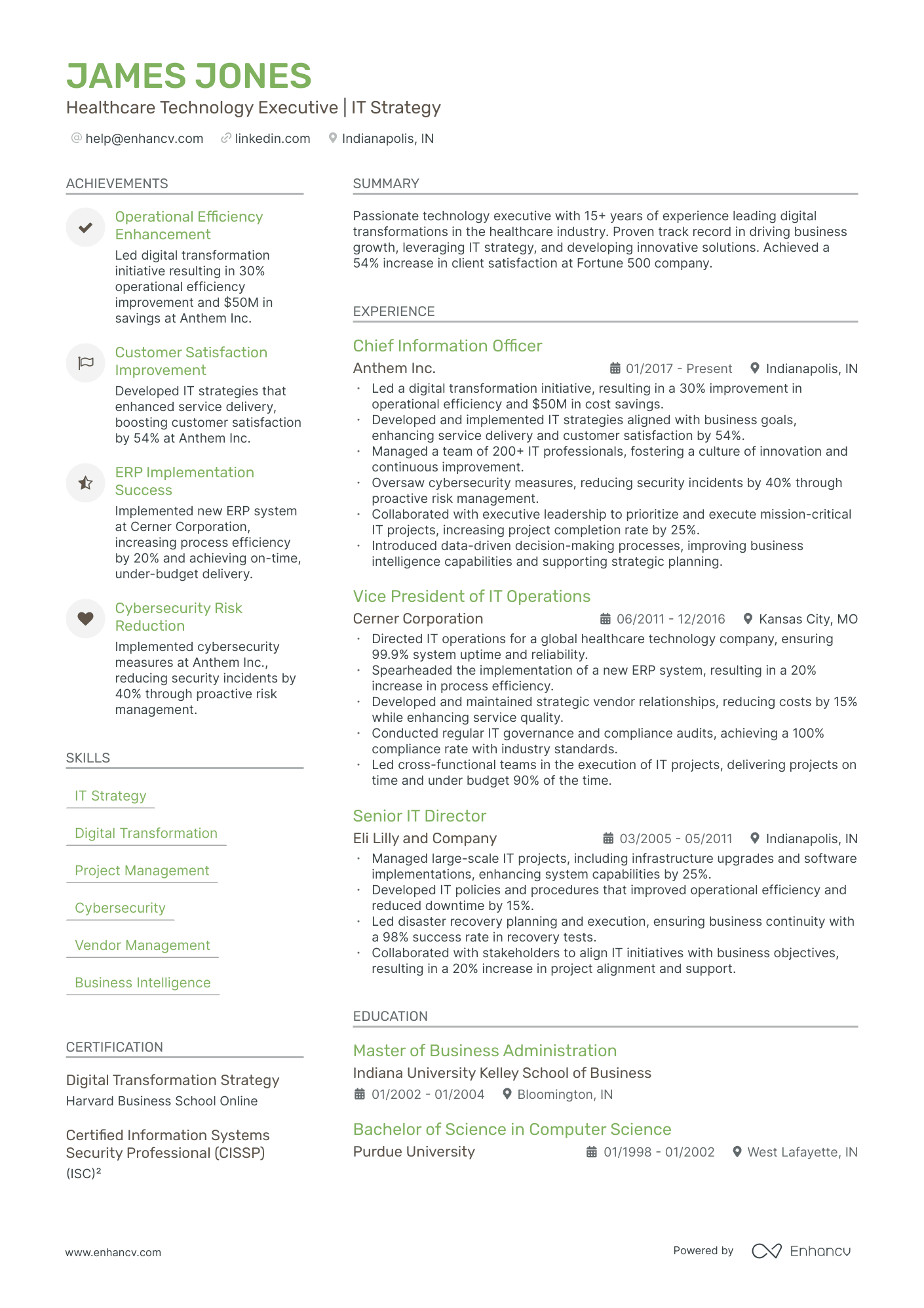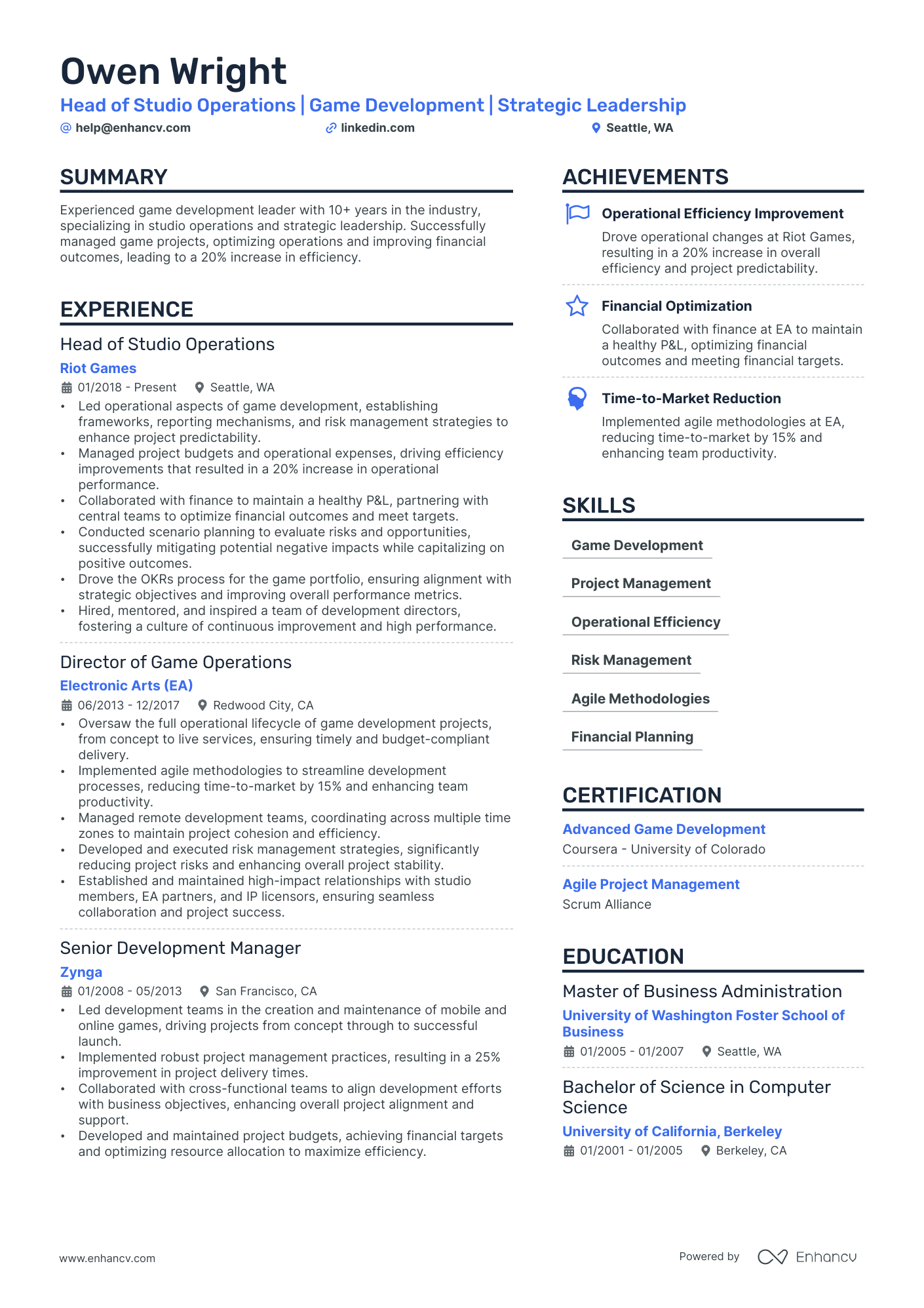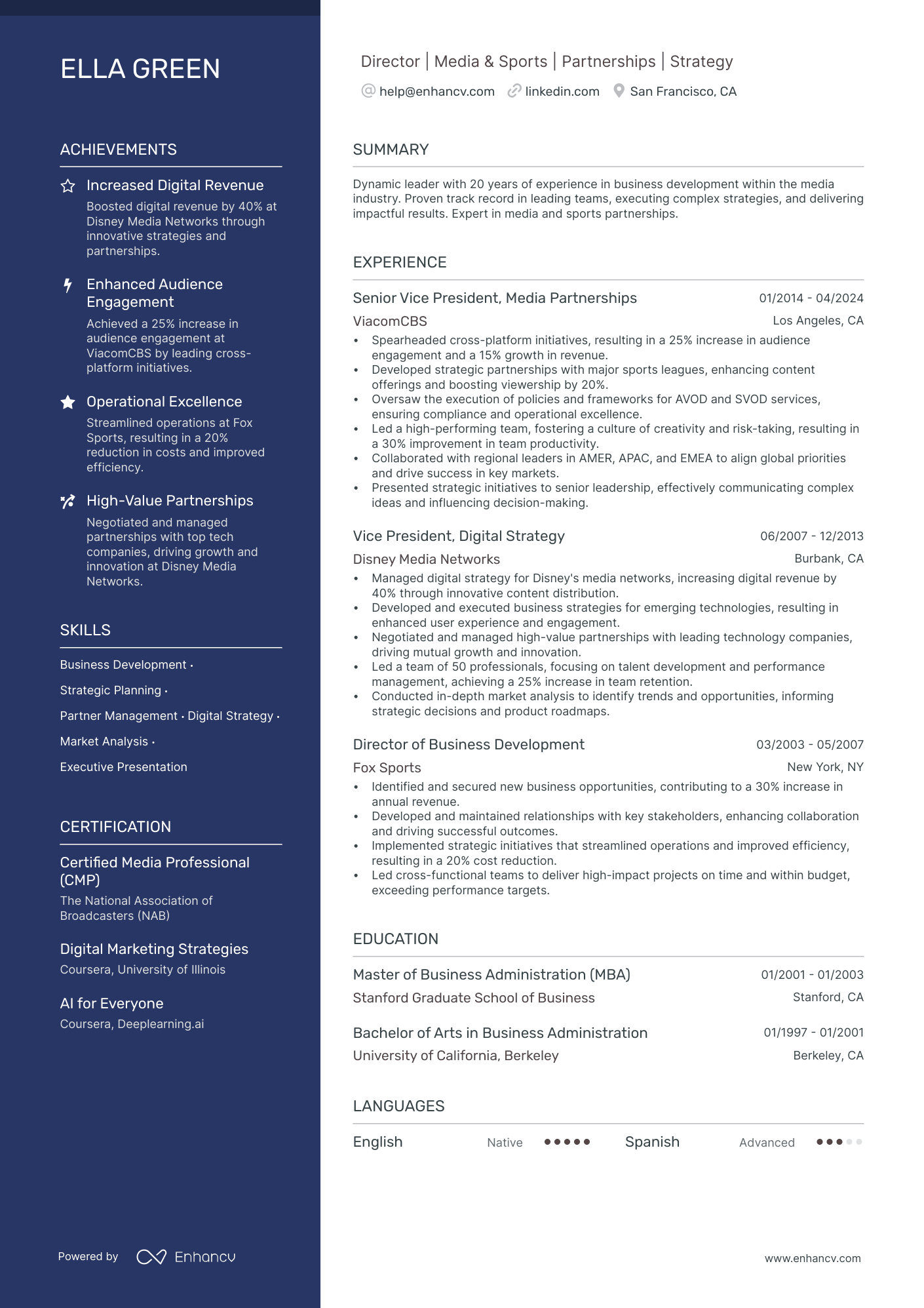After years of contributing to development teams and assuming leadership roles in SaaS, the next natural progression in your career path has arrived – securing a CTO position. However, attaining a C-level role is no small feat. This holds true whether you're considering switching companies or industries or aiming for a promotion within your current organization. In any case, you'll encounter competition more intense than for any previous position. What’s more, executive leadership roles are more often secured through your professional network than through traditional job listings.
Therefore, your resume must convey to recruiters and board members not only your soft skills and innovative thinking but also highlight your relevant past achievements and experiences. Additionally, the competencies required for a CTO role at a small, 9-person startup vastly differ from those needed at a multinational corporation.
In this guide, we’ll show you how to write a CTO resume that will get hiring managers excited and get you an interview.
This is what our CTO resume guide will cover:
- How to customize your resume for the specific company and industry you’re targeting;
- How to catch recruiters’ attention from the very beginning with the right formatting;
- How to use strategic resume sections to shine a light on your best capabilities;
- How to strike a balance between your technical and leadership skills to maximize your interview callbacks
If this article isn’t exactly the right one for you, check our other C-Level resume guides:
- CEO Resume
- CIO Resume
- IT DireCTOr Resume
- Software Architect Resume
- Information Technology Resume
- CTO cover letter
Chief Technology Officer (CTO) resume example
Here’s what really stands out in this CTO resume sample:
- The resume does a great job of highlighting specific achievements in each role, like leading projects that led to measurable improvements. This clearly shows they can deliver results, which is super important for a CTO.
- They’ve also included a good mix of technical skills, software knowledge, and hard skills directly related to the job, plus some extra relevant skills. This gives a well-rounded view of their abilities, perfectly matching what’s needed for a CTO role.
- By listing specific courses and certifications that are relevant to both technology and leadership, they show a strong commitment to continuous learning and professional growth.
- The summary section is excellent too. It really captures their passion for technology and leadership and highlights their most notable achievements and skills.
How to format a CTO resume that stands out
Recruiters look at hundreds of resumes a day and only spend a few seconds on each one. You need to make a strong impression within that tiny window.
One of the first things to decide is the type of layout you want to use. A reverse chronological resumeis the best choice in your case. Using this format allows you to highlight your most recent accomplishment prominently at the beginning of your resume, immediately catching the recruiter's eye. Reverse chronological resumes offer a coherent overview of your work history and allow you to spotlight the prestigious companies in your career. This is particularly beneficial if you have worked for well-known organizations.
Another common format is the functional resume. This style focuses on skills and experience rather than chronological work history. It can be beneficial if you’re switching careers or have gaps in your employment history. However, for a CTO position, this format might not be the best choice. Recruiters for high-level technical roles often look for a clear progression of responsibilities and achievements, which a functional resume doesn’t effectively showcase.
The combination (hybrid) resume merges elements of both reverse chronological and functional formats. It allows you to highlight your skills and achievements upfront while still providing a chronological overview of your work history. This format can work well for a CTO if you have significant technical skills and achievements you want to emphasize but still want to show a steady career progression. However, it can sometimes be longer and more complex, which might not be as appealing to recruiters looking for concise information.
CTO resume designs
These small details are very important for the readability of your resume.
- Fonts: Keep in mind that applicant tracking systems can read a wide range of serif and sans-serif fonts, so no need to stick to overused fonts like Times New Roman. Rubik and Lato work perfectly fine and will make your resume look neat and modern. Just make sure the size is set to 12pt.
- Margins: 1 inch is the standard margin size for resumes. While you can play adjust it in the Enhancv Resume Builder, the key is to balance it with the font and border size. Proper margins ensure your resume has enough blank space, making it easier to read.
- Template: Choose between a traditional or modern CTO resume template. Traditional templates offer a single-column design, which is great for fields like accounting and engineering. Modern templates feature two columns, allowing you to fit more content on one page, which is the ideal resume length.
What to put in the header of a CTO resume
Your header is the very first thing employers see and it’s your opportunity to grab their attention. Most candidates will include their names and contact info and move on to the next section.
Remember, every section must be both concise and engaging. Make your CTO resume more memorable by paying special attention to the following:
- A customized headlineto grab the recruiter’s attention and demonstrate the relevance of your experience to their company. As we’ve established, CTO responsibilities look different for different companies. Having “Chief Technology Officer” as your headline doesn’t communicate anything about your skills and abilities. Tailor yours to demonstrate how you will solve the company's problem. For example, you wouldn’t use the headline “Driving innovation in agile startups since 2008” if the company's problem is managing reliable networks.
- Link to your professional profile (LinkedIn, Github) to meet the expectations of hiring managers. The question is, which profile will you be linking to, LinkedIn or Github? Again, this requires a bit of digging into your target company to find out what kind of CTO they’re looking for. If your target CTO role is highly technical and you have to actively participate in the development of your product, prioritize linking to your GitHub profile. Alternatively, C-Level roles will be on the lookout for a strong LinkedIn presence and networking skills.
Aside from the header, you should prioritize the following:
The top sections on a Chief Technology Officer resume
- Experience section to showcase your career trajeCTOry and major achievements, supported by quantified results.
- Key achievements in technology to add credibility and highlight specific successes and milestones in technology development and leadership.
- Technical skills and expertise to list your technical abilities and demonstrate hands-on experience and understanding of technology.
- Education and certifications that provide background on formal education and any relevant certifications.
HR professionals will shortlist candidates with both outstanding expertise and strong leadership skills. According to them, your CTO resume should also demonstrate the bulleted assets in the box below.
What recruiters want to see on your resume
- Proven experience in leading large-scale technology projects and initiatives
- Skills in strategic planning and technology roadmap development
- Expertise in current and emerging technologies relevant to the company's industry
- Strong leadership and team management abilities
- Evidence of successful collaboration with other C-suite executives and stakeholders
If your resume is already looking great, use the upload button below and let our resume checker do the assessment.
Is your resume good enough?
Drop your resume here or choose a file. PDF & DOCX only. Max 2MB file size.
Pleased with the result? If yes, save your resume as a PDF. This is the best way to ensure it can be viewed from all types of devices.
How to write a CTO resume experience section
Now that you’ve got an incredible header that will impress recruiters, let’s get to work on your experience section. You’ve already hooked recruiters with your strong headline, you don’t want to lose them with a boring and irrelevant experience section.
A common mistake people make when writing a targeted resume is they take the “tailor your resume to the job description” advice a bit too far.
Don’t just copy and paste a company’s job requirements into your CTO resume. It will look bad, and boring, and you’re not fooling anyone.
Instead, ask yourself the following questions: What are the problems and pain points of the company you’re targeting? What kind of a CTO would this company need to address these challenges? What’s in your previous experience that makes you uniquely equipped to excel at this goal?
If you’re struggling to take this information and write something about yourself, try the following steps:
- Decide what qualities the organization is looking for in the candidate.
- Analyze your strongest qualities.
- Focus on where the two meet and apply this formula: [Action verb] [this] as measured in [that] by doing [X].
Now you’re building a narrative where you have the right experience to meet company needs and can support it with specific examples.
Let’s take a look at one bad and one strong example.
- •Facilitated platform adoption among customers
- •Identified key partnerships
- •Regularly spoke at events and conferences
We can see a few missed opportunities here.
- The resume needs more numbers. Right now, it's all a bit "we did good stuff." For example, "Facilitated platform adoption among customers" could be more impactful if it included specific metrics, such as by what percentage customer adoption increased or the number of new customers acquired as a result of these efforts.
- Missing impact of actions. We're listing things done, but not what they actually did for the business or tech world. Saying "Teamed up with some big players" needs a follow-up, like did it make us money, or get us into new markets?
- Vague roles and contributions. The statements are somewhat vague and don’t fully capture the scope of the CTO's role or contributions. For a leadership position like a CTO, it would be better to detail strategic initiatives, technological innovations, or significant projects.
There’s a much better way of writing the experience section entry. Note the use of the above-mentioned formula to show the candidate is qualified for the job.
- •Accelerated outbound sales cycle by 330% by designing and implementing customer acquisition platform for training and managing technical sales personnel.
- •Established and curated strategic partnerships with 6 out of 10 top state manufacturing companies which resulted in $20M additional annual revenue.
- •Led re-architect effort of a core SaaS product to reduce the platform deployment time for clients by 2 months.
What do we see here?
- Quantifiable achievements. Each point includes specific, measurable outcomes. For example, accelerating the sales cycle by 330% and generating an additional $20M in annual revenue are concrete achievements that clearly demonstrate the impact of the actions.
- Clear value added. These bullets go beyond stating actions; they articulate the direct benefits, such as enhancing sales efficiency, forging valuable partnerships, and significantly reducing platform deployment time.
- Strategic and technical contributions. The experience here showcases a blend of strategic vision and technical expertise. It paints a picture of a leader capable of driving both business strategy and technical innovation.
Quantifying your achievements and thus adding value to your experience is a hygiene faCTOr for any good resume. Read on if you’re looking for some extra ideas on how to do that.
How to quantify impact on a CTO resume
You already have considerable experience in your field, but how do you stand out? Support your achievements with quantifiable evidence. Below are our best strategies for showcasing your success on a resume through measurable results.
- Highlight the percentage reduction in system downtime achieved through infrastructure improvements to demonstrate your ability to enhance reliability and operational efficiency.
- Detail the increase in user engagement metrics (such as daily active users or session length) following UI/UX revamps. This will showcase your focus on customer satisfaction and product usability.
- Specify the revenue growth attributed to new technology implementations or digital transformations to show direct impact on the company’s bottom line.
- Mention the cost reduction percentage achieved by optimizing cloud services or introducing automation. Cost management and operational efficiency matter.
- Report the growth in market share following the launch of technology-driven products or services. This sheds light on your ability to capture new business opportunities.
- Quantify the improvement in software release cycle time due to the adoption of Agile methodologies or CI/CD pipelines.
- Describe the increase in cybersecurity incident detection and response speed as a result of your security protocols overhaul to emphasize your role in protecting the company's digital assets.
- Detail the scale of data analytics or machine learning initiatives you led, including the percentage increase in actionable insights generated.
Whatever results you add to your resume, focus on the ones that will be the most impactful for your target job.
How to write a CTO resume for a startup
A CTO in a startup will have a very different experience from one in a large organization. Tailoring the resume to suit the seCTOr – whether it’s tech, finance, healthcare, etc. – is crucial. Here’s a list of the most important faCTOrs to consider when adjusting your resume to the startup ecosystem.
- Highlight your direct impact on key business metrics, such as revenue growth, user base expansion, and cost savings through technology initiatives. This can be included in the "Achievements" section to demonstrate the value you've brought to the business. Remember to talk about your role in developing or launching key products and how you led the product from concept to market.
- Detail how you scaled the startup's technology to support growth, including specific technologies or architectures you implemented. This information can be included in the "Hard skills" or “Projects" section and showcases how you handle the startup's evolving needs.
- Use the “Experience" section to emphasize your ability to lead a team, nurture talent, and manage resources effectively. Consider briefly mentioning significant challenges or failures and the lessons learned, as this can show resilience, adaptability, and a growth mindset—valuable traits in any startup environment.
- Feature thought leadership initiatives in the "Community Involvement" section. If you've engaged in speaking engagements, publications, or contributed to open-source projects, include these to highlight your expertise and influence in the tech community. If you established strategic partnerships or played a role in building a community around your technology, detail these efforts to show your broader impact on the ecosystem.
PRO TIP
For high-level positions like CTO, networking is often key. Platforms like LinkedIn, industry-specific events, and membership in professional organizations like the IEEE Computer Society can be crucial.
How do you list your hard and soft skills on a resume
The position you’re applying for will determine the best format choice for your skills section. Some companies will want you to jump in alongside the engineers and exercise those DevOps skills. Others will look to your leadership skills to recruit and retain top-level IT talent, execute global IT strategy, and scale operations.
If you have a software background, you’re probably more comfortable talking about Java, Python, MySQL, and other technologies, so let’s take a look at the most common ones.
Best hard skills for your Chief Technology Officer (CTO) resume
- Cloud computing platforms (AWS, Azure, GCP)
- DevOps and Continuous Integration or Continuous Deployment (CI or CD) practices
- Cybersecurity and information security protocols
- Data Analytics and Big Data technologies
- Machine learning and Artificial Intelligence
- Software Development Life Cycle (SDLC) management
- Agile and Scrum methodologies
- Blockchain technology
- Internet of Things (IoT) solutions
- Mobile platform development (iOS, Android)
- Enterprise resource planning (ERP) systems
- Customer relationship management (CRM) software
- Network architecture and administration
- Programming languages (Python, Java, C#, JavaScript)
- Database management systems (SQL, NoSQL)
- Virtualization and containerization (Docker, Kubernetes)
- User Experience (UX) design principles
- Project management tools
- Financial forecasting and budget management
- Regulatory compliance and data privacy laws (GDPR, CCPA)
Almost every CTO comes from a technical background, so putting all the focus on your tech skills won’t make you stand out — every candidate will have a great section.
Soft skills are often what separates a good CTO from a great CTO. Leadership, communication, and team management play a major role in CTO responsibilities. Below is a list of what recruiters will be looking for in your work history.
Best soft skills for your Chief Technology Officer (CTO) resume
- Leadership
- Strategic thinking
- Problem-solving
- Communication
- Adaptability
- Innovation
- Team building
- Decision-making
- Negotiation
- Emotional intelligence
- Conflict resolution
- Time management
- Visionary thinking
- Resilience
- Empathy
- Stakeholder management
- Project management
- Critical thinking
- Persuasion
- Listening
However, simply listing soft skills on your resume won’t be enough to convince recruiters. Like the achievements in your experience section, it is best to demonstrate by showing examples. Presenting soft skills in a real-world context allows you to show evidence of your interpersonal skills and emphasize your achievements once again.
For example, you analyze the target job description and see that part of the job is to present a platform to partners and clients through events and conferences. Use your past experience and show your presentation skills in an engaging context:
“Delivered keynote speech at Global 2020 Innovative Tech Conference on customer management workflows.”
Alternatively, use the CTO template in our resume builder tool and add your soft skills in the section labeled “key achievements”. This will add a nice twist to your resume.
How to list certifications and education on your resume
The majority of CTO positions will require a bachelor’s degree in computer science, engineering, or a closely related field. Depending on the size and scope of the company, some may even require an MBA.
As you format and write your resume, keep in mind that the recruiter should already want to interview you before they even get to your education section. The degree may be the final requirement, but your header, experience, and skills should be what really make you stand out.
Here’s a real-world sample from a CTO resume:
The same goes for certificates: those can strengthen your overall profile, especially if you have certifications in areas where the company is struggling.
If you’ve set your sights on a particular CTO position and need a bit more experience in a particular skill, you might want to look into relevant certifications and courses.
See some examples below:
Best certifications for your Chief Technology Officer (CTO) resume
- Certified Information Systems Security Professional (CISSP)
- Certified Information Technology Professional (CITP)
- Project Management Professional (PMP)
- Certified ScrumMaster (CSM)
- AWS Certified Solutions Architect
- Microsoft Certified: Azure Solutions Architect Expert
- Google Cloud Certified — Professional Cloud Architect
- Certified Data Professional (CDP)
- Certified Information Systems Auditor (CISA)
- Technology Business Management (TBM) Executive Foundation Certification
With all the details in place, let's dive into the most compelling part of your CTO resume—the summary.
How to write a Chief Technology Officer resume summary
When hiring managers look at your resume, they want to know that you can provide solutions to company problems. Being a jack of all trades won’t cut it.
As with every other section on your resume, the resume summary should be adapted to what the specific company is seeking. Even though the summary is an overview of your entire work history, it still needs a clear focus to get the attention of HR managers.
Your CTO resume summary should convey that you can identify problems, know how to solve them, and can implement solutions. This is what will set you apart from other candidates who provide blanket resumes that don’t target specific requirements.
Not sure how to squeeze this into 5 sentences max? Use this framework to make your good CTO resume a great CTO resume:
- Analyze job requirements and company profile.
- Identify the global technological pain within the company.
- Think about what kind of CTO the company would need to address the challenge.
- Think of what kind of CTO would exceed the company’s expectations.
- Use these keywords and insights to craft an irresistible resume summary.
Let’s explore how we can transform a mediocre summary into something professional.
This is obviously a bad example for 3 main reasons:
- It lacks specificity and quantitative details. The summary is overly broad and lacks specific achievements, such as the exact impact on startups or the scale of growth. This vagueness doesn't convey any depth of the professional's expertise or accomplishments.
- Misses technical depth and leadership role. For a role as pivotal as a CTO, it's crucial to mention technical leadership, strategic direction, and the technologies or methodologies employed.
- Overlooks key achievements and skills. While brevity can be a virtue, in this case, the summary is too brief to effectively communicate the individual's experience.
With a few strategic edits, this is what can be achieved:
- Detailed and quantitative achievements. This summary outlines the candidate's experience and accomplishments like significant revenue growth and the global scale of the product's expansion.
- Showcases a blend of technical and strategic leadership. The candidate can both lead technical initiatives and contribute to business growth. This dual focus is crucial for a CTO who should navigate and unite both technical and business domains.
- Highlights global influence and product scalability. By mentioning the product's expansion to over 80 countries and translation into 9 languages, the summary showcases the candidate's success in scaling products globally.
Additional sections for a Chief Technology Officer resume
If you’re a seasoned CTO, you’ve probably contributed a lot to innovation. Your resume is a good opportunity to shine a light on your research and development (R&D) initiatives. A dedicated section can showcase your ability to drive technology forward and stay ahead of industry trends.
How to put an R&D section on a resume
Similarly to sections like “Projects”, “R&D” will highlight your role in spearheading projects that may lead to new products and will show recruiters you’re intrinsically motivated.
These are the steps to follow when writing a “Research and Development” section:
- Start with the project title.
- Add the duration of the project.
- Write one sentence to explain the objective of the project or a short summary of your work.
- Use a couple of bullet points to list the project findings and outcomes. Of course, don’t miss the chance to give numbers. Quantify your impact every step of the way.
- •Successfully decreased equipment downtime by 50% and maintenance costs by 20% for our pilot manufacturing plant.
- •The platform has been adopted by five major manufacturing companies, significantly boosting our SaaS offerings.
Include specific and job-relevant examples of R&D projects (technology innovations introduced, or patents obtained) to enhance your CTO's resume. It’s a great way to show your direct impact on the company's growth and positioning in the market.
Key takeaways
Chief Technology Officers hold the reins for a reason. Your resume needs to showcase more than just your tech skills—it should highlight your impact and your ability to scale projects and teams. With this guide, we’ve shown you how to:
- Tailor your resume specifically for the job or seCTOr you’re eyeing, making it impossible to ignore.
- Craft a resume that’s not just clean, but compelling, encouraging recruiters to dive deeper.
- Use numbers to underscore your achievements, giving your claims the weight they deserve.
- Balance the showcase of your technical expertise with your leadership finesse, demonstrating you're equipped to lead on all fronts.
CTO resume examples
Explore additional cto resume samples and guides and see what works for your level of experience or role.
By Role





